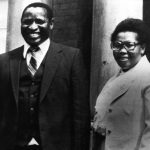From the Archive | Bram Fischer: Afrikaner revolutionary
Advocate, communist and antiapartheid activist Bram Fischer died on this day in 1975. Earlier, he had escaped from custody and spent almost 10 months eluding the apartheid security apparatus.
Author:
8 May 2019

Bram Fischer made a daring escape from custody during his trial and spent 290 days in hiding before being rearrested. Here is the story of that time, from Stephen Clingman’s acclaimed biography of Fischer.
This is an edited excerpt from Stephen Clingman’s Bram Fischer: Afrikaner Revolutionary (David Philip/Mayibuye Books/University of Massachusetts Press, 1998 & Jacana Books, 2013).
23 January 1965 – 11 November 1965
“ADV. FISCHER VERMIS”; “GROOT SOEKTOG NA FISCHER”. Three-quarter-inch headlines in the Vaderland and Transvaler told their story: Advocate Fischer had disappeared, and a countrywide search was under way. Ilse was interviewed by the papers: “Father fled as I slept,” reported the Rand Daily Mail, recounting how, when Ilse Fischer and Pat Davidson realised Bram was not up in time for court, they had knocked on his door and received no reply. Entering his room they had found it empty, save for a pile of letters alongside the bed to friends and legal advisers. “I was shocked when I saw my father had gone,” was Ilse’s comment.
Of course that was not how it happened, and if Ilse was shocked it was not in that way.
Ilse had to be involved, because it was she who had to help Bram escape. During the months after Molly Fischer died, and especially in those last few weeks of preparation, there was an emotional proximity between father and daughter that had not existed in quite the same way before. Ilse was now not only daughter but collaborator, affiliated through sympathy and personal outrage to the cause of her father, and all the untold ambiguities of familial loyalty could be channelled and harnessed in this form. Through what had happened to Molly, through her own experience, the detention of Sholto Cross, Alan Brooks and others, Bram’s world was now also hers.
Related article:
They talked and planned in her room, tucked away upstairs at the back of the house, using the Rivonia Trial technique of keywords on paper – the harsh training of the last few years now a way of life – or they went out into the garden, the setting of a family’s identity now given a starker utilitarian value. All the time they knew how closely they were being watched. Evening strolls to walk the dog revealed odd cars parked about the neighbourhood, some empty, some bearing blank-faced figures in suits. They also had to gather the clothing and equipment Bram would need for his disappearance. Observing a middle-aged trousseau accumulating under his bed, Pat asked in her straightforward way what was up. So she was brought into it too – or perhaps that was Bram’s way of engineering a suitable form for Ilse to accept Pat’s participation.
The departure was set for the Saturday before the court reconvened. Early that morning Bram wrote his final letters, among them his two letters to Ilse, one of which he gave her, one of which he secreted behind. Then, at about nine, he, Ilse and Pat went via the kitchen through a connecting door into the garage, to avoid being seen from the street. Bram squeezed on to the floor of their small Volkswagen Beetle, between the front and back seats. One of the others opened the garage doors: Ilse was to drive, Pat was in the front passenger seat. And so it was that they left the house, Ilse’s first task to shake the inevitable police tail following her.
Uncertainty and daring kept adrenalin in ready supply, eyes attuned to the slightest element amiss on the road, ears expectant for the police siren’s wail. To add to matters, the car was prone to stalling, and whenever they stopped Ilse would have to manage quick switches between clutch and brake, pumping the accelerator with growling roars. Some time later she received an obscure message from Bram about the car and “pink heels”, and went through the Volkswagen with a fine-tooth comb, sure it must mean something significant. But Ilse had been barefoot during the escape, and Bram was referring only to her heels – all he could see working away at the pedals from his observation point on the floor. It was his little joke.
Related article:
They took him to the suburb of Killarney, just off Riviera Road, where one of apartheid’s munificent shopping complexes later arose, but then was just a patch of veld. That was where Ilse and Pat dropped him off. Bram walked across to a nearby block of flats which had a row of garages at the back. There – as Violet Weinberg had arranged – he was met by a young man who opened one of the garage doors as he came over. Bram had not said much to Ilse and Pat before he left, just that he would be in contact at some stage. They had no idea of how near or how far he was going. He was driven off by the young man.
When Ilse and Pat returned to Beaumont Street, they had to enact an elaborate charade, creating the impression that all was normal and Bram was still at home. They did this even for Tias – though in his case it wasn’t too difficult, as he spent most of his time in the garden, and Bram was usually upstairs in his study – but there was a less well-disposed audience to convince. So every now and then Pat and Ilse would stand where they thought the police bugs might pick up their conversation, and complain rather loudly about how hard Bram was working, and how it was high time that he came down.
That evening when Tias cooked dinner, they made a show of calling Bram, took a third plate, put food on it and ate it, to keep all the appearances alive. Every night Bram had a set routine of parting the curtains and checking all the windows; so one of them put on his pyjamas and did exactly the same, then climbed into his bed and rumpled it as if he had slept there. The following night they did it all over again. It was of necessity an amateurish performance, using only what skills and resources were available. Yet amidst the taut anxiety of the moment, there was a certain element of fun, and somewhat miraculously everything worked.
On the Sunday the doorbell rang: there was a man whom neither Ilse nor Pat had seen before, asking for Bram. Pat was afraid to say he was busy, thinking the man might insist on waiting; so she said Bram was out doing some work, and that the best thing would be to try him at chambers the following day. At that the unknown caller left, but both then and later Pat suspected he may have been a visitor from the Special Branch.
The same day there was an expected guest, this time Harold Hanson, there to collect the letter he was to read out in court the following day. He neither asked for Bram nor did he read the letter, and it was Pat’s impression that he knew exactly what was in it. In fact when Bram told Hanson what he planned to do, Hanson had said he would do anything to help him. The only hitch over the letter was that initially Pat lost it, so anxious about secrecy that she forgot where she had hidden it. She had put it in her squash raquet cover, and there was inner and outer turmoil until she found it.
On the Monday – the day the trial reconvened – Pat went to court, ostensibly to hand Bram’s letter to Hanson. Ilse couldn’t bear to go with her, and stayed home, though at some stage during the day she phoned Sholto in panic because, although Bram was gone and the news must have broken, the Security Police had not arrived, and the tension of waiting was terrible. It was that call too, she felt, that kept the police from arresting her, because of her genuine alarm at her father’s disappearance.
For the next day or two still there was nothing: the Special Branch, perhaps in some shock of their own, stayed away. And then finally they raided, taking whatever they could find, including Bram’s second letter to Ilse, and a document in his handwriting they had been searching for since the Rivonia case. After that there was only one further search – when Ilse and Pat, having a drink one evening in the twilight, remarked sardonically for the benefit of the listening devices that the flowers at the bottom of the garden appeared to be moving and that it must be time to go and feed Bram. The next morning the police came in and dug up the daisies.
Related article:
Related article: NPA to re-examine Neil Aggett’s death
While speculation ran rife as to where in the world Bram was, or the plastic surgery he would most likely undergo in order to change his appearance, in fact he had not gone very far, and his methods of disguise were more modest. From Killarney he had been driven off to Rustenburg, about 140km north-west of Johannesburg, to a small cottage on a secluded farm owned by a Mrs Milindton (she was the mother-in-law of Stanley Uys, the journalist who had visited Bram and Molly during the Rivonia Trial). There Mrs Milindton (who may or may not have known who Bram was, and who had something of a reputation as a health-food enthusiast) put him on a diet; for his purposes this was not only to change his shape, but to lessen the floridity caused by his high blood pressure.
For the rest, he had learned well from his theatre designers. The object was not to become, dramatically, someone else, but to alter the characteristics that identified him as who he was. He shaved the hair back on the front of his head, to make it look as if he were going bald, and dyed what remained of it auburn – not only for the overt disguise, but once again to make his face look less florid by contrast. He grew a goatee beard which, along with his eyebrows, he also dyed auburn, and took to a pipe, which, if kept in his mouth while he spoke, altered the quality of his voice. He exchanged the thick black rims of his glasses for a lighter, rimless pair – and that knee of his, which had swung out when he walked ever since his rugby accident in Oxford, he learned to keep in check. To add to the effect Bram used a walking stick, taking quicker and lighter steps, altogether more prim. He altered the mannerisms of his face and the gestures of his hands, the essential instincts and revelations of the body.
Advocate, accused and now actor: Bram changed from the solid Afrikaner lawyer and instantly recognisable figure at the centre of his world to a slight and strange, miasmic fellow on the fringes of society who, though diffident and polite, looked as if he never knew the time. He took advantage of the mental after-image of who he had been to become someone whom no one would suspect. He became the negative in the camera, the translation whose inner reality negotiates with outer difference, the being whose edges are blurred. He was the ghost who manages to walk the streets in the places where once he had lived.


